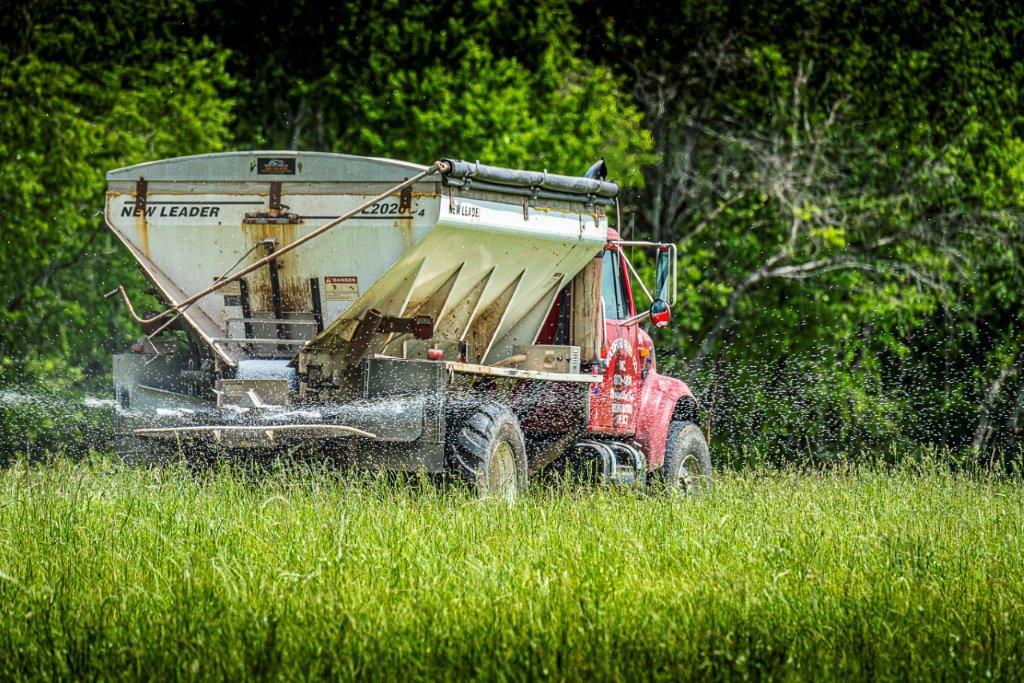Fertilizer Nitrogen Sources for Forage Production

As the 2021 forage production season approaches, nitrogen (N) management will be a key component of soil fertility programs for pastures and hayfields. The following is an update on the fertilizer N sources that can be used to increase both yield and forage quality and inhibitors/stabilizers that can be used to prevent N losses.
Fall and early spring applied dry bulk fertilizer blends intended to provide potash (K), phosphate (P) and sulfur (S) will likely contain N, due to use of dry fertilizer materials like monoammonium phosphate (MAP, 11-52-0), diammonium phosphate (DAP, 18-46-0) and ammonium sulfate (AS, 21-0-0-24S). These fertilizer N salts dissolve readily in moist soil and are excellent N sources since ammonium-N is plant available, not often subject to N loss and does not need N loss protection. However, due to high cost per pound of N, these are not normally viewed as N sources.
Sole N sources for forage are marketed in both solid and liquid forms. Although any of these can be used, regardless the time-of-year, urea (46-0-0) and urea-ammonium nitrate solutions (UAN, 28- 30- or 32-0-0) are most commonly used. More expensive and harder to purchase, ammonium nitrate (AN, 34-0-0) – half the N is ammonium-N and half is nitrate-N – is another solid fertilizer salt behaving similarly to MAP, DAP and AS.
Urea quickly dissolves in the soil and then hydrolyzes to form ammonium-N. Urea soil behavior is complicated by the possibility of ammonia gas volatilization losses due either to an increasing soil pH (up to pH 9) near the dissolving urea granule or to the near-granule presence of urease (more likely in Kentucky’s pasture and hay fields). Urease, an enzyme widely found on both living vegetation and dead crop residues, catalyzes ammonia volatilization during urea hydrolysis. Under certain conditions, urease can cause a large fraction (up to 35%) of urea-N to be lost. Factors affecting the amount of loss are soil temperature (warm) and moisture (moist but drying), wind (a nice breeze), presence of vegetative/residue cover/urease and a soil pH greater than 6.5.
In UAN solutions, half the N is dissolved urea, a quarter is ammonium-N and a quarter is nitrate-N (from the dissolved ammonium nitrate). UAN is compatible with other liquid nutrient sources (ammonium polyphosphate, APP, 10-34-0; ammonium thiosulfate, ATS, 12-0-0-26S) and certain herbicides (weed and feed) which accounts for increasing UAN use. UAN-urea is subject to volatilization loss as discussed for urea, above. UAN volatilization loss is smaller than that from urea, per pound of applied N, because just half the UAN-N is from urea.
Volatilization loss can be avoided/minimized, without inhibitors, using certain timing, rate, or N source management practices. Urea or UAN applied before May 1, when soils are generally moist and cooler, will generally experience little volatilization loss. After May 1, apply urea or UAN when: a) rainfall (0.25 inch or more) incorporation is expected within two-four days; and/or b) there is less forage canopy, resulting in increased fertilizer soil contact. If the urea or UAN application seems likely to suffer volatilization loss, consider a) applying 15-25% more N per acre, b) changing the chosen N source or c) modifying the urea or UAN by asking the fertilizer retailer to add a volatilization inhibitor.
It is important to note that there are two types of N loss inhibitors, nitrification inhibitors and urease/volatilization inhibitors – unrelated to each other and helpful in two very different situations. Some commercial products combine both types but should not be bought when only volatilization loss is anticipated. In forage production, a need for nitrification inhibition is unusual. Effective urease/volatilization inhibitor active ingredients include: N-(n-butyl) thiophosphoric triamide (NBPT); N-(n-propyl) thiophosphoric acid triamide (NPPT); Duromide (undetailed derivative of NBPT); and, less effective, ammonium thiosulfate (ATS). In many situations, NBPT alone will control volatilization, but some commercial products combine NBPT with other urease inhibitors (especially NPPT and Duromide) to extend/improve volatilization inhibition. For a more information on nitrogen sources and volatilization inhibitors, contact your local extension office.
Source: March 1 Kentucky Forage News. John Grove, PhD, professor, and Chris Teutsch, PhD, extension associate professor, both in the Department of Plant and Soil Sciences, provided this information.
